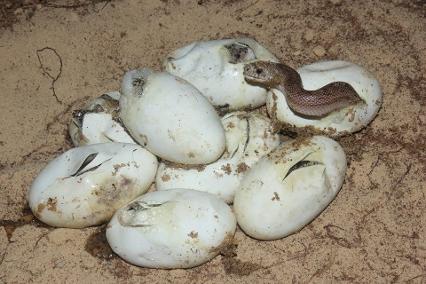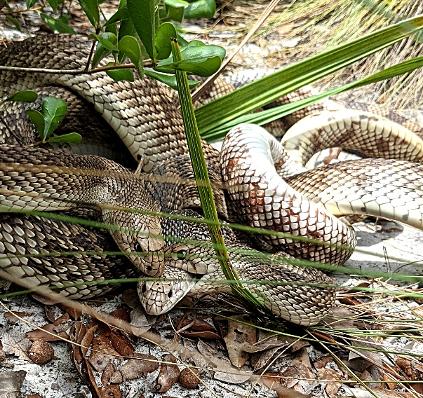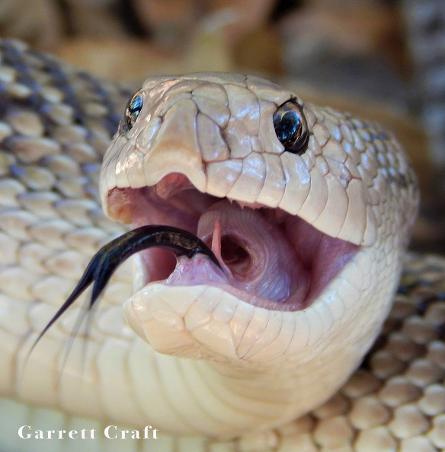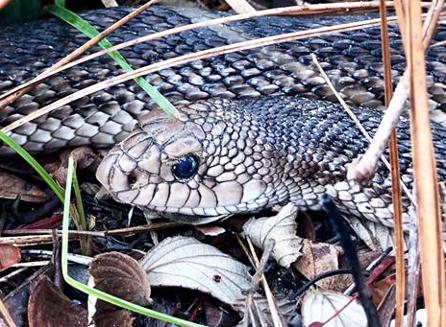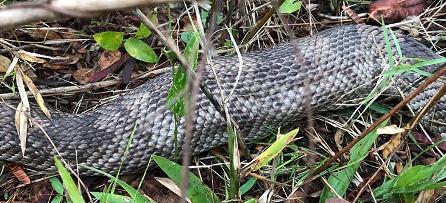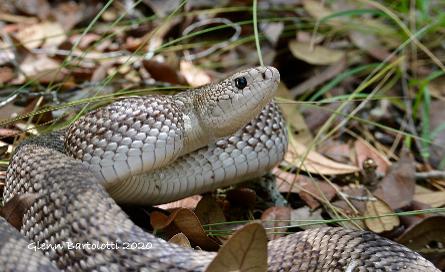Florida Pine Snake - Pituophis melanoleucus mugitus
Ghosts of the Sandhills
Physical Description
The Florida Pine snake (often called the “Southern” Pine snake) is a large, robust species. It typically ranges from 3 to 4 ft., but can exceed approximately 80in making it one of the largest snakes in the United States. These snakes show a wide array of markings depending both on location within the state and individual variation within populations themselves; typically, the snakes show a patterned area on the last third of the body consisting of lighter ground coloring and large saddles of pigmentation giving an almost banded appearance. Their scales are heavily keeled, with a single, highly enlarged rostral scale which wraps up, and onto, the most anterior portion of the nose of the snake. Their head is fairly indistinct from the rest of the body, with a neck which isn’t readily apparent. These snakes are functionally harmless, but give quite a defensive show to scare off would-be predators via S-ing up, hissing and sometimes mock striking and tail rattling.
Life History
Their diet consists of anything they can subdue, with the staple being bird eggs, small mammals and, where they occur, pocket gophers (Geomys sp.). This snake shows a preference for inhabiting areas with dense Pocket Gopher activity and will live within their tunnel systems while heavily feeding on them, although Pocket Gophers are not strictly necessary for Florida Pines. This species will, in fact, be found in areas with no Pocket Gophers where they turn to other food sources for substance. Nesting typically takes place from June to August, with their eggs hatching from approximately September to October (Franz 1992). The average clutch size for this species ranges from 4-12 eggs (Bartlett and Bartlett 2003), with approximate incubation time for eggs ranging from 67-72 days (Franz 1992).
Habitat and Distribution
The species typically relies on loose, well-drained soil characteristic of upland xeric habitats of scrub and sandhill. Their ecological niche within these habitats involves a highly fossorial nature (burrowing, or underground existence) where they very infrequently venture above ground where they are encountered by Man. Florida Pines can also utilize edge habitats involving mesic hammocks, or palmetto prairies where little burrowing can occur. Individuals living within these ecosystems are perhaps less fossorial than their counterparts in more xeric habitats. The Florida Pine can be infrequently found in localized distributions ranging North from southwestern South Carolina, west to Alabama, and Florida along and among the ancient sand ridges (Conant and Collins 1991, Ernst and Ernst 2003, Florida Natural Areas Inventory 2001).

Threats:
Habitat loss has been an issue for the Florida pine snake. By 1987, 88% of scrub habitat in Florida had been lost to development (Kautz et al. 1993). Other habitat for this species includes the longleaf pine community, of which 97% has been converted to agriculture, pine plantations, and urban areas (Noss et al. 1995). Habitat loss and fragmentation is a result of commercial and residential development, silviculture (controlling the growth and quality of forests through timber management), mining, and road construction. The alteration of its fire-dependent habitat can cause less favorable living conditions for the Florida pine snake due to the encroachment of hardwoods. The removal of stumps can threaten the pine snake because it decreases the amount of underground habitat structures (Means 2005). Pine snakes might be experiencing increased rates of predation of adults, hatchlings, or eggs from nine-banded armadillos, feral hogs, and red imported fire ants (R. Zappalorti, Herpetological Associates, pers. commun. 2011). Other threats include mortality caused by roads, humans, and domesticated pets (Jordan 1998).
Listing Status
Federal Status: Protected
FL Status: State Species of Special Concern
FNAI Ranks: G4T3?/S3 (Globally: Apparently Secure, Sub sp. Rare [Tentative Ranking]/State: Rare)
IUCN Status: Not ranked
Click on the map for county local FL Pine Snake photos
Home.mp3
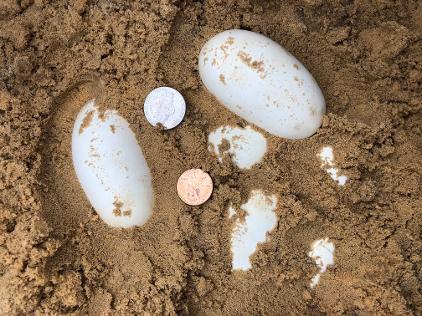
9 Pine Snake eggs found July 20, 2018.
This clutch was found at the bottom of an active gopher tortoise burrow while relocating tortoises in Citrus Co. Another clutch of 5 eggs was inadvertently excavated in xeric hammock, and the 3 least damaged eggs are hatching today. One egg had a pretty large punture that was patched with a piece of Neosporin-smeared paper towel. The babies will be released.
